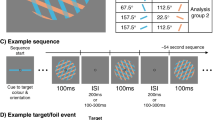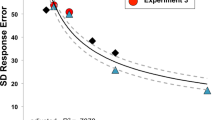Abstract
By voluntarily directing attention to a specific region of a visual scene, we can improve our perception of stimuli at that location1. This ability to focus attention upon specific zones of the visual field has been described metaphorically as a moveable spotlight or zoom lens that facilitates the processing of stimuli within its ‘beam’2,3. A long-standing controversy has centred on the question of whether the spotlight of spatial attention has a unitary beam or whether it can be divided flexibly to disparate locations2,4,5,6. Evidence supporting the unitary spotlight view has come from numerous behavioural3,7,8,9,10 and electrophysiological11,12 studies. Recent experiments, however, indicate that the spotlight of spatial attention may be divided between non-contiguous zones of the visual field for very brief stimulus exposures (<100 ms)13,14. Here we use an electrophysiological measure of attentional allocation (the steady-state visual evoked potential) to show that the spotlight may be divided between spatially separated locations (excluding interposed locations) over more extended time periods. This spotlight division appears to be accomplished at an early stage of visual-cortical processing.
This is a preview of subscription content, access via your institution
Access options
Subscribe to this journal
Receive 51 print issues and online access
$199.00 per year
only $3.90 per issue
Buy this article
- Purchase on Springer Link
- Instant access to full article PDF
Prices may be subject to local taxes which are calculated during checkout



Similar content being viewed by others
References
LaBerge, D. Attentional Processing (Harvard Univ. Press, Cambridge, Massachusetts, 1995)
Posner, I. P. & Petersen, S. E. The attention system of the human brain. Annu. Rev. Neurosci. 13, 25–42 (1990)
Eriksen, C. W. & Yeh, Y. Y. Allocation of attention in the visual field. J. Exp. Psychol. Hum. Percept. Perform. 11, 583–597 (1985)
LaBerge, D. & Brown, V. Theory of attentional operations in shape identification. Psychol. Rev. 96, 101–124 (1989)
Shaw, M. L. & Shaw, P. Optimal allocation of cognitive resources to spatial locations. J. Exp. Psychol. Hum. Percept. Perform. 3, 201–211 (1977)
Castiello, U. & Umilta, C. Splitting focal attention. J. Exp. Psychol. Hum. Percept. Perform. 18, 837–848 (1992)
Posner, M. I., Snyder, C. R. R. & Davidson, B. J. Attention and detection of signals. J. Exp. Psychol. Gen. 109, 160–174 (1980)
Pan, K. & Eriksen, C. W. Attentional distribution in the visual field during same-different judgements as assessed by response competition. Percept. Psychophys. 53, 134–144 (1993)
McCormick, P. A., Klein, R. M. & Johnston, S. Splitting vs. shared visual attention: An empirical commentary on Castiello & Umilta (1992). J. Exp. Psychol. Hum. Percept. Perform. 24, 350–357 (1998)
Kiefer, R. J. & Siple, P. Spatial constraints on the voluntary control of attention across visual space. Can. J. Psychol. 41, 474–489 (1987)
Eimer, M. Attending to quadrants and ring-shaped regions: ERP effects of visual attention in different spatial selection tasks. Psychophysiology 36, 491–503 (1999)
Heinze, H.-J. et al. Attention to adjacent and separate positions in space: An electrophysiological analysis. Percept. Psychophys. 56, 42–52 (1994)
Awh, E. & Pashler, H. Evidence for split attentional foci. J. Exp. Psychol. Hum. Percept. Perform. 26, 834–846 (2000)
Hahn, S. & Kramer, A. F. Further evidence for the division of attention between noncontiguous locations. Vis. Cognit. 5, 217–256 (1998)
Regan, D. Human Brain Electrophysiology: Evoked Potentials and Evoked Magnetic Fields in Science and Medicine (Elsevier, New York, 1989)
Müller, M. M. et al. Effects of spatial selective attention on the steady-state visual evoked potential in the 20–28 Hz range. Cognit. Brain Res. 6, 249–261 (1998)
Di Russo, F. & Spinelli, D. Spatial attention has different effects on the magno- and parvocellular pathways. NeuroReport 10, 2755–2762 (1999)
Müller, M. M., Teder-Sälejärvi, W. & Hillyard, S. A. The time course of cortical facilitation during cued shifts of spatial attention. Nature Neurosci. 1, 631–634 (1998)
Müller, M. M. et al. in Oscillatory Event-related Brain Dynamics (eds Pantev, C., Elbert, T. & Lütkenhöner, B.) 325–342 (Plenum, New York, 1994)
Reeves, A. & Sperling, G. Attention gating in short-term visual memory. Psychol. Rev. 93, 180–206 (1986)
Weichselgartner, E. & Sperling, G. Dynamics of automatic controlled visual attention. Science 238, 778–780 (1987)
Duncan, J., Ward, R. & Shapiro, K. Direct measurement of attentional dwell time in human vision. Nature 369, 313–315 (1994)
Peterson, M. S. & Juola, J. F. Evidence for distinct attentional bottlenecks in attention switching and attentional blink tasks. J. Gen. Psychol. 127, 6–26 (2000)
Moore, C. M., Egeth, H., Berglan, L. & Luck, S. J. Are attentional dwell times inconsistent with serial visual search? Psychonom. Bull. Rev. 3, 360–365 (1996)
Müller, M. M. & Hübner, R. Can the attentional spotlight be shaped like a doughnut? Evidence from steady state visual evoked potentials. Psychol. Sci. 13, 119–124 (2002)
Müller, M. M., Teder, W. & Hillyard, S. A. Magentoencephalographic recording of steady-state visual evoked cortical activity. Brain Topogr. 9, 163–168 (1997)
Hillyard, S. A. et al. Combining steady-state visual evoked potentials and fMRI to localize brain activity during selective attention. Hum. Brain Mapp. 5, 287–292 (1997)
Clark, V. P. & Hillyard, S. A. Spatial selective attention affects early extrastriate but not striate components of the visual evoked potential. J. Cognit. Neurosci. 8, 387–402 (1996)
Martinez, A. et al. Putting spatial attention on the map: Timing and localization of stimulus selection processes in striate and extrastriate visual areas. Vis. Res. 41, 1437–1457 (2001)
Clark, V. P., Fan, S. & Hillyard, S. A. Identification of early visual evoked potential generators by retinotopic and topographic analyses. Hum. Brain Mapp. 2, 170–187 (1995)
Acknowledgements
We thank N. Williams, H. Messmer and C.-M. Giabbiconi for help in data recording. This work was supported by the Deutsche Forschungsgemeinschaft and by NIMH.
Author information
Authors and Affiliations
Corresponding author
Ethics declarations
Competing interests
The authors declare that they have no competing financial interests.
Rights and permissions
About this article
Cite this article
Müller, M., Malinowski, P., Gruber, T. et al. Sustained division of the attentional spotlight. Nature 424, 309–312 (2003). https://doi.org/10.1038/nature01812
Received:
Accepted:
Issue Date:
DOI: https://doi.org/10.1038/nature01812
This article is cited by
-
Preattentive facilitation of target trajectories in a dragonfly visual neuron
Communications Biology (2022)
-
Effect of sustained selective attention on steady-state visual evoked potentials
Experimental Brain Research (2022)
-
What factors influence the switch from unitary to divided attention?
Psychological Research (2022)
-
When cognitive control harms rather than helps: individuals with high working memory capacity are less efficient at infrequent contraction of attentional breadth
Psychological Research (2021)
-
The steady-state visual evoked potential (SSVEP) reflects the activation of cortical object representations: evidence from semantic stimulus repetition
Experimental Brain Research (2021)
Comments
By submitting a comment you agree to abide by our Terms and Community Guidelines. If you find something abusive or that does not comply with our terms or guidelines please flag it as inappropriate.



